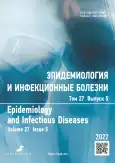Features of the epidemiological situation with acute urogenital gonococcal infection in the Perm Region for the period from 2010 to 2021
- Authors: Oborin D.A.1
-
Affiliations:
- Perm Regional Center for the Prevention and Control of AIDS and Infectious Diseases
- Issue: Vol 27, No 5 (2022)
- Pages: 272-279
- Section: Original study articles
- URL: https://bakhtiniada.ru/1560-9529/article/view/134016
- DOI: https://doi.org/10.17816/EID115995
- ID: 134016
Cite item
Abstract
BACKGROUND: According to WHO, more than 60 million people get sick with gonococcal infection every year. Recently, there has been a decrease in the incidence of gonorrhea in Russia. However, in addition to Neisseria gonorrhoeae, other microorganisms may also cause acute urethritis. However, there is no record of morbidity for them.
AIM: This study analyzes the epidemiological situation of the incidence of аcute genital gonococcal infection and urethral nonspecific inflammatory diseases in the Perm Region for the period 2010–2021.
MATERIALS AND METHODS: A comparative retrospective analysis of the incidence of аcute genital gonococcal infection and urogenital tract nonspecific inflammatory diseases among patients of the Perm Region was performed using the annually published data of official statistics. The data on the incidence of genital tract nonspecific inflammatory diseases were obtained from outpatient patient records of three clinics in the city of Perm. Epidemiological and statistical information processing methods were used in the work, and the Pearson coefficient was used for correlation analysis.
RESULTS: The long-term dynamics of the incidence of аcute genital gonococcal infection among the population of the Perm Region was characterized by a pronounced downward trend. However, in recent years, the number of genital tract infections in women and men has increased. The decrease in the incidence of аcute genital gonococcal infection is most likely due to changes in the properties of N. gonorrhoeae, causing significantly more difficult laboratory diagnoses and often leading to false negative results. In addition, the high polymorphism of cultural, morphological, and biochemical properties of conditionally pathogenic microorganisms further complicates the identification stage of the isolated strains.
CONCLUSION: As a result, against the background of a decrease in the incidence of аcute genital gonococcal infection, an increase in the incidence of genital tract nonspecific inflammatory diseases was revealed. The peculiarities of the epidemic process of аcute genital gonococcal infection and urogenital tract and the complexity of laboratory diagnostics of these conditions cause their untimely detection.
Full Text
##article.viewOnOriginalSite##About the authors
Denis A. Oborin
Perm Regional Center for the Prevention and Control of AIDS and Infectious Diseases
Author for correspondence.
Email: daoborin@yandex.ru
ORCID iD: 0000-0001-6426-5217
MD
Russian Federation, 21, Sviyazev St., Perm, 614088References
- Gonorrhoea cases on the rise across Europe. Available from: https://www.ecdc.europa.eu/en/news-events/gonorrhoea-cases-rise-across-europe Accessed: Dec 23, 2022
- Oborin DA, Nikolaeva NV, Godovalov AP, Karpunina TI. Etiology of purulent-inflammatory processes in the genital tract: suspicions of clinicians and problems of laboratory confirmation. Clinical Laboratory Diagnostics. 2020;65(5):328–331. (In Russ). doi: 10.18821/0869-2084-2020-65-5-328-331
- Pleininger S, Indra A, Golparian D, et al. Extensively drug-resistant (XDR) Neisseria gonorrhoeae causing possible gonorrhoea treatment failure with ceftriaxone plus azithromycin in Austria, April 2022. Euro Surveill. 2022;27(24):2200455. doi: 10.2807/1560-7917.ES.2022.27.24.2200455
- Andreeva IV, Korolev SV, Stetsyuk OU, Kozlov SN. Non-gonococcal urethritis in men: modern views on etiology and approaches to treatment. Lechachi Vrach. 2010;(8):2–9. (In Russ).
- Kozlov SN, Korolev SV, Andreeva IV, Stetsyuk OU. Modern ideas about the problem of non-gonococcal urethritis in men. Clinical Dermatology and Venereology. 2011;9(2):7–19. (In Russ).
- Potekaev NN, Gomberg MA, Gushchin AE, Kim DG. Tactics of managing patients with anaerobic urethritis: guidelines No. 132. Moscow; 2021. 19 p.
- Sboev AS, editor. State report “On the sanitary and epidemiological situation in the Perm region in 2010”. Perm; 2011. 253 p. (In Russ).
- Kostarev AS, editor. State report “On the state of sanitary and epidemiological well-being of the population in the Perm region in 2015”. Perm; 2016. 269 p. (In Russ).
- Kostarev AS, editor. State report “On the state of sanitary and epidemiological well-being of the population in the Perm region in 2020”. Perm; 2021. 240 p. (In Russ).
- Kostarev AS, editor. State report “On the state of sanitary and epidemiological well-being of the population in the Perm region in 2021”. Perm; 2022. 240 p. (In Russ).
- Belyakov VD, Semenenko TA, Shraga MKh. Introduction to the epidemiology of human infectious and non-infectious diseases. Moscow: Meditsina; 2001. 264 p. (In Russ).
- Babushkin SА, Ivenskikh VI, Godovalov AP, et al. Selected epidemiological and microbiological aspects of morbidity of community-acquired pneumonia. The Bulletin of Contemporary Clinical Medicine. 2017;10(4):12–15. (In Russ). doi: 10.20969/VSKM.2017.10(4).12-15
- Onopoko VF, Argunov AV, Chemezov AP. Features of the course of diseases of the urogenital tract in men with opportunistic microflora. Siberian Medical Journal. 2013;(4):115–116. (In Russ).
- Godovalov AP, Nikolaeva NV, Karpunina TI, Oborin DA. On the assesment of the etiological significance of bacteria detected in the male genital tract. Journal of Microbiology, Epidemiology and Immunobiology. 2022;99(4):428–435. (In Russ). doi: 10.36233/0372-9311-257
- Godovalov AP, Karpunina TI. The Microbiota Continuum along the Reproductive Tract in Women with Infertility. Journal of Microbiology, Epidemiology and Immunobiology. 2020;97(1):26–31. (In Russ). doi: 10.36233/0372-9311-2020-97-1-26-31
Supplementary files











